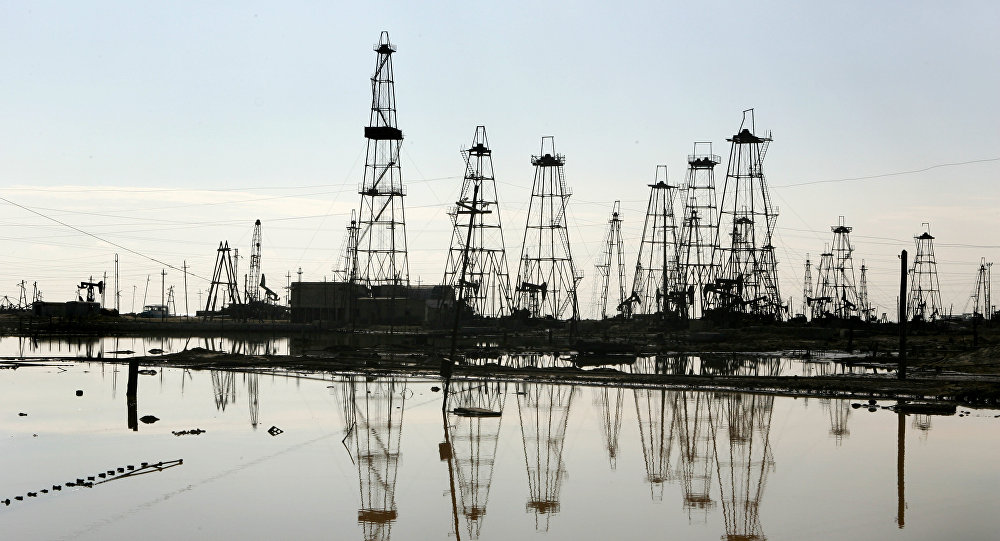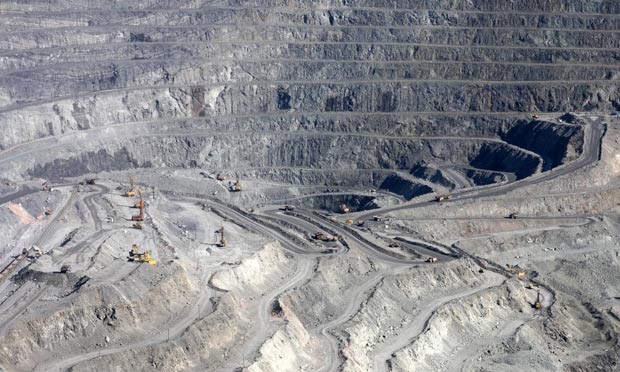Azerbaijan is famous for its oil and gas fields. 2/3 of the territory of the republic is rich in hydrocarbons. The largest number of oil and gas fields is located on the Absheron Peninsula, in the shelf zone of the Caspian Sea, in the archipelago of Baku and Absheron. In addition, southeastern Shirvan, central Aran, Gobustan, Jeyranchol, Ajynour, Siyazan are rich in oil.
Naftalan oil is known all over the world for its medicinal properties.
The largest number of natural gas fields are located in Garadagh, the shelf zone of the Caspian Sea, the archipelago of Baku and Absheron. The Lesser Caucasus is rich in ore deposits. There are deposits of iron, titanium, gold, silver, copper, cobalt, chromite, poly metals, molybdenum, etc.
Of the nonmetallic deposits, Gobustan, Apsheron, and Tovuz limestone, Shakhtakhtinsky travertine (Nakhichevan AR), Dashkesan marble, Verkhne-Adjikend gypsum, and Hajiveli quartz sands are of great economic importance.
There are mineral springs with different chemical compositions in the territory of Azerbaijan. Due to the richness of their composition, the territory of Azerbaijan is called the "museum of mineral waters". Istisu in Kalbajar region, and Badamli Sirab — in Nakhchivan AR is known far beyond the borders of Azerbaijan.
Districts such as Surakhany and Zykh of the Apsheron peninsula, Galaalty in the Divichinsky region, Turshsu in the Julfinsky region are famous for their medicinal waters. On the Talysh Mountains, on the southern and northeastern slopes of the Greater Caucasus, the advantage is made up of thermal waters.
Combustible minerals

The combustible minerals of the Azerbaijan Republic are oil, gas, shale, peat, etc. Of these, oil and gas are of industrial importance. Oil is produced onshore and in the Caspian Sea. The Republic of Azerbaijan (region of the Absheron Peninsula) is one of the first oil countries in the world. Back in the 7th-6th centuries BC, oil was extracted and delivered to many countries of the world in Absheron. Until 1985, Azerbaijan produced approximately 1.2 billion tons of oil (25% — from offshore oil fields). The oil of the Azerbaijan Republic is low-sulfur and is a high-quality product. The density varies in a wide range (780-940 kg m3 ).
In Naftalan, from the Maikop and Akchagil deposits, oil, the only one in the world for its healing properties, is produced. The gases produced in the republic have a hydrocarbon composition. They are in the composition of oil, free ("gas cap"), in the form of pure gas. Over the past 30-35 years, many gas condensate fields have been explored and commissioned. At the moment, there are 8 oil and gas regions in the Republic (Apsheron, Shemakha — Gobustan, lower — Kura, Baku archipelago, Ganja, Yevlakh, Caspian and Kura interfluve — Gabyrry) and 2 promisings (Ajinour and Jalilabad) regions. In the Absheron, Shemakha-Gobustan, Nizhnekurinsky districts, as well as in the area of the Baku archipelago, the main oil and gas group is a productive stratum. The thickness of this layer, consisting of the sequence of sand, sandstone, and clayey interlayers, reaches 4000 m (in some places even more).
Oil shale and brown coal of the Maikop-Apsheron age were found on the territory of the republic.
Ore minerals

These minerals (iron, aluminum, chromite, gold, silver, lead, zinc, cobalt, molybdenum ores, etc.) form various deposits in the mountainous parts of the republic.
Iron ores (magnetite, hematite) in the Republic of Azerbaijan are found in four sources: segrational-magmatic, skarn-magnetite (contact-metasomatic), hydrothermal-metasomatic, and sediments. Of these, only the deposits of the skarn-magnetite type — Dashkesan, South Dashkesan, and Demir — are of industrial importance. These deposits are formed from volcanic, piclastic. and volcanic-sedimentary rocks of Callovian, Kimmeridgian. Oxford ages. Crossing the Dashkesan syncline along the arrow, the granitoid of the same name is in close contact with the intrusion and is related to it by origin. The industrial reserve of Dashkesan iron ore deposits (category A + B + S) is 250 million tons.
Industrially significant cobalt ores (cobaltin, glaukodot) are known in the Dashkesan ore region. Here cobalt ores were formed both independently (Verkhne-Dashkesan deposit) and together with skrnovo-magnetite ores.
Gold deposits are most common in the Lesser Caucasus and the Nakhichevan Autonomous Republic. The appraisal work of the gold deposits discovered in the basins of the Alinjachai and Kurekchay rivers was carried out, the initial reserves were calculated and the industrial significance was determined.
Chromite deposits (Goydarya, Kazymbinasy, Ipek, Khataveng) are mainly located in the Lachin and Kalbajar regions.
Manganese ore occurrences are located on the northeastern slope of the Lesser Caucasus (Mollajalilli, Dash Salakhli, etc.) and within the Nakhichevan Autonomous Republic (Bichenak, Alyagi).
Copper ores in the Azerbaijan Republic in the formations of copper pyrite and copper-porphyry. The mineral composition of the copper-pyrite ores consists mainly of pyrite and chalcopyrite. In many cases, sphalerite and galena are found in the composition of the ore. In the composition of the copper-porphyry formation, in addition to copper, there are molybdenum and precious metals in small quantities. Ores of both formations are found in daughter quartzites in the Gadabay copper region. The most widespread is the porphyry copper formation. In addition to the Karabakh and Kharkhar deposits (Gadabay copper region), there are large manifestations of porphyry copper formation in this region. Stocks of stock have been exhausted in the Gadabay region; the eponymous copper pyrite deposit is known. Copper-porphyry occurrences (Damirli and Khachinchay) are noticeable in the copper region of Mehman.
Copper-zinc deposits and occurrences (Dzhikh-Sagator, Mazymchay, Karabchay) are represented on the southern slopes of the Greater Caucasus in terrigenous deposits of the Lower Jurassic period.

On the territory of the Nakhichevan Autonomous Republic, ore mineralization of the copper-porphyry type is located mainly on the Meghri-Ordubad granitoid batholith (Diakhchay, Goygel, Heydag, etc.).
In the Balakan-Zakatala zone, there are industrially important deposits of lead and zinc (Filizchay, Katekh, Katsdag, etc.), as well as copper, cadmium, gold, silver, etc. elements.
Deposits and manifestations of molybdenum of the vein-like type are found in the Delidag (Teimuruchandag, Bagyrsag, etc.) and Ordubad (Paragachay, Diakhchay) copper regions.
The largest deposit of aluminum ore (alunite) is located in the Dashkesan region (alunite deposit in Zaglik). Alunite manifestations are known in Shamkir and Ordubad regions. The alunite deposit in Zaglik has been in operation since 1960. This deposit is the largest in Europe. At the Ganja aluminum plant, potassium fertilizers and soda are obtained from this ore.
In the Nakhichevan Autonomous Republic, in the Permian deposits, manifestations of bauxite (Sadarak, Sharur) are known — the best raw material for aluminum.
Deposits and manifestations of mercury are widespread in the central part of the Lesser Caucasus (Kalbajar-Lachin zone). The reserves of the largest deposits have been calculated — Aghyatag, Shorbulag, Levchay (Kelbajar), Gilyazchay, and Narzanli (Lachin). Mercury (kinofar) is found in areas of acidic igneous rocks of various ages and compositions, most of all in volcanic deposits and volcanic rocks of the Upper Cretaceous period. Cinnabar is associated with pyrite, chalcopyrite, antimonite, magnetite, hematite, sphalerite, and other minerals.
Antimony does not form independent deposits. Antimony in the form of antimonite mineral in the Levchay mercury deposit forms deposits in the form of an ore mass.
The largest arsenic deposit in the Azerbaijan Republic is known as Gedabek (Bitdibulag energetic deposit) and Julfa (Daridag orpiment-realgar deposit). This deposit was operated until 1941. The ore is in the form of stock. The composition of the ore consists of orpiment, realgar, antimonite, arsenopyrite.
Small manifestations of tungsten in the form of scheelite are observed at the border of the Meghri-Ordubad granitoid plutons in the Ordubad and Lachin regions.
Non-metallic minerals
Nonmetallic minerals in the Republic of Azerbaijan play an important role in the overall balance of mineral resources. This group includes rock salt, gypsum, anhydrite, bentonite clay, building materials, pyrite, barite, semi-valuable and colored stones, dolomite, Icelandic spar, etc.
Rock salt deposits are located in the Nakhichevan Autonomous Republic (Nekhram, Duzdag, Pusyan). The deposits are located in Miocene sandstones, clay, limestone, and marl deposits. The balance reserve of the Nekhramovskoye field in the B + C1 category is 73,600 thousand tons, in the C2 category — 64,200 thousand tons. Potential resources are estimated at 2-2.5 billion tons. Commercial reserves of the Duzdag field in the A + B + C1 category are equal to 94,517 thousand tons, in the C2 category — 37,810 thousand tons.
Deposits of gypsum and anhydrite are formed in chalk deposits in the villages of Upper Agjakend and Manash of the Gadabay region. Commercial reserves of deposits located 120 km southeast of the city of Nakhichevan (Araz; gypsum) and around the city of Ganja (Gyadzh) in the category A + B + C1 amount to 40,632 thousand tons

Many deposits and manifestations of bentonite clays are known (Gobustan, Goranboy, Sheki, etc.). The largest deposit was discovered in the Gazakh region (Dash Salakhli). The deposit was formed from the impact of hydrothermal solutions with volcanic rocks of the Santonian age; industrial reserves amount to 84,553 thousand tons.
There are many building materials on the territory of the Republic of Azerbaijan. Industrial reserves of stone-cubic deposits (Guzdek, Dovlyatyarly, Dilagarda, Shakhbulag, Naftalan, Mardakyan, Dash Salakhli, Zayyam, Ayydag) in category A + B + C1 are equal to 295,836 thousand tons of facing stone (Gyulbyakht, Dashkesanlab, Shakhlytakhty) - 23951 thousand tons.
In Karadag there are deposits of raw materials suitable for the production of cement (limestone, clay, etc.). Clays used in the production of bricks are mined in many places. Limestone deposits are suitable for the production of flux and carbide with reserves of 8.3 thousand m 3 that have been identified in the Siyazan region. Volcanic tuff is a zeolite raw material and is located, and its deposit (Aydag) is located 7 km north-west of Tovuz. The prospective reserves of tuffs at the Ayydag deposit are 20 million tons.
There are almost 20 barite deposits and occurrences in the Azerbaijan Republic (Chovdar, Bashgishlag, Gushchu, Tonashen, Zailik, Azad, Chaikend). Deposits of the vein-like type.
Half-value and colored stones were found in the Dashkesan and Ordubad regions of the Lesser Caucasus (granite, amethyst), in Kedabek (tourmaline), and Santonian volcanic (chalcedony, agate, heliotrope). Agate collections are found in the Adjikend and Gazakh deposits, in the Upper Cretaceous volcanic in the form of secretions, nests, almonds, veins, and lenses. There are jewelry and technical types. Industrial reserves of the Adjikend group of agates are 286.8 tons. Of these, 65.8 tons are suitable for the jewelry industry.
Near the village of Nekhram (Nakhichevan AR) and in Boyanata Mountain (Gobustan) there are large reserves of dolomite. Quartz sands for the glass industry were found in Gobustan, the Absheron Peninsula, and the Guba region.
Displays of Icelandic spar (Nagorno-Karabakh) and large reserves of lithographic stone (Mirikend deposit, Nagorno-Karabakh) were discovered.
In Shemakhi, Kalbajar, and Khanlar regions there are manifestations of chemical paints.
Healing mud is located on the Absheron Peninsula, Lake Masazir, Gobustan, and the Lower Kura depression, in the areas of the eruption of mud volcanoes.



